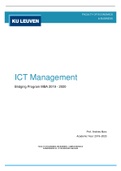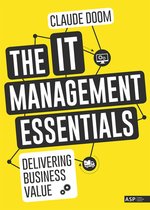FACULTY OF ECONOMICS
& BUSINESS
ICT Management
Bridging Program MBA 2019 - 2020
Prof. Andries Marc
Academic Year: 2019–2020
FACULTY OF ECONOMICS AND BUSINESS - CAMPUS BRUSSELS
WARMOESBERG 26 – B 1000 BRUSSELS BELGIUM
,BUSINESS INFORMATION SYSTEM
1 Information technology in a business environment (Ch2)
1.1 The organization as a system
Any organization, whether it be small or large, can be viewed as a system. This means that it
consists of parts that work together to achieve a certain goal. The ultimate goal of companies
and of other organizations, like the government or non-profit organizations, is to produce
added value for their customers. In a classic commercial business, this means the delivery of
products and services to draw a profit from the added value. For a government organization,
delivering added value means that the organization provides a useful service to the citizens.
1.2 Business processes
In order to deliver added value, an enterprise needs to do certain things. For instance, a
commercial company will accept orders from customers, will manufacture products, and will
deliver these products to its customers. The company will send invoices and have them paid,
will advertise, etc. Each of the things an enterprise does in order to create, directly or
indirectly, added value is called a business process.
We can define a business process as a structured set of activities executed in an organization.
A business process needs time, space and resources to be executed. It can be composed of
both other business processes and activities.
An activity is a simple action, which is normally part of a business process. Like a business
process, it needs time, space and resources. In its turn, an activity can be composed of sub-
activities. To execute the activity, the sub-activities are executed, usually in a prescribed order.
An activity that cannot be reasonably split into sub-activities is called an elementary activity.
The exact split between business processes and activities is unclear, but is also irrelevant.
Long sequences of activities are clearly business processes. Elementary actions are clearly
activities. Usually, the term business process is used for rather complex operations, requiring
multiple resources, and extended in terms of time or space. The term “activity” then refers
to simpler operations, using less complex resources and rather limited in time and space.
A business function is a collection of related business processes. We find a large diversity of
business functions, business processes and activities within organizations. A number of these
occur in nearly all organizations. Other processes are specific to certain groups of
organizations, to certain types of organizations (e.g. government), or certain business sectors.
1.3 The value chain
An organization executes sequences of business processes that belong to different business
functions. Subsequent business processes may therefore be totally different. Each process
creates added value and increases the value of the product or service being produced by the
organization. A value chain is a sequence of business functions via which business processes
are sequenced to produce products or services with added value.
The concept of the value chain has been developed and popularized by Michael Porter. He
looked upon a business as a sequence of processes, part of several business functions. Porter
called these business functions “activities”. A company product evolves through all these
functions, with each function adding value. A number of business functions of the value chain
are called primary activities. They contribute directly to the added value of the products. The
primary activities in the model of Porter are as follows
1
,• Inbound logistics: This business function contains activities such as the receipt, storage
and distribution of raw materials.
• Operations: This includes the actual production: the conversion of raw materials into
finished products.
• Outbound logistics: Here we find the processes bringing the finished products to the
customers: storage, transportation and order processing.
• Marketing and sales: This includes processes such as promotion, pricing, the making of
offers and sales transactions.
• Service: This business function groups the post-sales activities: support, installation,
repairs and training
Other business functions in the value chain are the support activities. The processes in these
functions ensure that the primary activities can run smoothly. The support activities in the
value chain of Michael Porter are as follows
• Firm infrastructure. This includes the acquisition and management of the infrastructure
needed to keep the organization operational. Here we find business processes such as
general management, financial management and plant management. Information
technology is also a part of this activity.
• Human resource management: Here we find the processes of selection, hiring and
management of employees.
• Technology development: These processes enable the acquisition of the necessary
knowledge and competences: research and development and process automation.
• Procurement: This business function includes the acquisition of resources (raw materials
and services) to execute the business processes.
Finally, the margin is the difference between the total value of the products of the
organization and the total cost of the primary and support activities.
An organization can use the value chain model to develop a competitive advantage. Porter
argues that such an advantage can be realized by systematically examining all activities along
the value chain. Each activity can then be optimized to increase the efficiency. Activities along
the value chain may also be rearranged to increase the overall efficiency of the organization.
Therefore, the model is also useful to determine where information technology should be
used within an organization in order to gain a competitive advantage.
2
,1.4 Value systems and the supply chain
An organization can interconnect its internal value chain with the value chains of other
organizations. For instance, an organization may connect its inbound logistics to the outbound
logistics of its suppliers. Similarly, the outbound logistics of an organization may be connected
to the inbound logistics of its distributors and even its customers. In this way, an “extended
value chain” is created, extending over several organizations. Porter called this a value system
By interconnecting the value chains of a series of organizations, we obtain one single system,
from raw materials to the delivery of finished products to the customers. The complete
system of organizations and resources to convert raw materials into finished products is called
the supply chain. A supply chain often contains several linked value systems and value chains.
It is obvious that a good control of the processes along the supply chain is essential for an
efficient production process. The management of the supply chain and the communications
and logistics involved have become a separate management discipline, called supply chain
management. Modeling all processes along the supply chain enables the optimization and
alignment of these processes, leading to more efficient production processes. Information
technology may contribute to this by providing better communications and by managing the
information needed to keep the supply chain running.
There are several models of the supply chain. Each of these models describes the business
processes along the supply chain.
1.5 Information systems
A computer system is a single unit for the creation, the storage, the management and the
processing of data. Such a system may consist of several pieces of hardware and software. It
is still considered to be a single system, because it has one single housing, one single CPU, or
because it runs one discrete operating system. A few examples of computer systems are:
• A PC with Microsoft Windows 10 and a printer, connected via a USB cable.
• An IBM mainframe server with the z/OS operating system and 150 TByte of disk storage.
• A Linux/Apache/MySQL/PHP (“LAMP”) web server, connected to the Internet.
• An Xbox One game console.
• A mobile phone.
• A Cisco 4331 router
An information system is a collection of equipment, services and human effort supporting the
creation, storage, management and processing of information. Some simple information
systems consist of one single computer system. However, many information systems consist
of more than one computer system. The constituent computer systems are then
interconnected by a network, locally within a single building (the local area network or LAN),
or worldwide via so-called wide area networks (WAN). In such a setting, the computer
systems cooperate to automate business processes or to perform scientific calculations. For
instance, personal computers throughout the world collaborate in the so-called SETI@home
project to search for intelligent life in outer space.
Usually, we associate information systems with electronic computers. However, information
systems are older than computers. Before there were electronic computers, there were filing
3
, cabinets, card-index boxes and hand-written cashbooks. Ancient civilizations used clay tablets
and even pieces of rope to store and process information. Of course, information technology
progressed rapidly with the introduction of the first useful electronic computers in companies
and governments between 1950 and 1960. Today, nearly all information systems consist of
electronic computers, although here and there some filing cabinets and card-index boxes are
still being used with success.
1.6 Information technology in businesses
Organizations use information systems to support and automate business processes. Such
systems are called business information systems. They usually support business functions and
processes like order fulfillment, accounting, production planning and logistics.
Improving the efficiency of business processes by using technology is not a new idea: it has
existed since the industrial revolution, when engineers investigated how machines and new
production techniques could improve industrial processes. A prime example of the results of this
research is the assembly line, which spectacularly improved the efficiency of product assembly.
There are three ways to use information systems in businesses. Each of these can be seen as
a phase in the more efficient use of information technology. The three phases are:
1. Data processing
In this first phase, individual business processes are supported by the storage and processing
of the data used by these processes. It is important to note that only isolated business
processes or small groups of business processes are involved. Data processing may or may
not make use of computers. Examples of data processing are:
• Cash books for accounting;
• The use of a PC with a text processing application to create a meeting report;
• The elaboration of a business plan using a spreadsheet program.
2. Task automation
In the phase of task automation, information systems are used to make the execution of
business processes and groups of related business processes more efficient. Task automation
differs from data processing in two important ways:
1. We aim for the automation of complete business processes.
2. We automate groups of related business processes or even complete business functions
using a single information system.
A number of properties of task automation are:
• Monolithic systems, automating many business processes.
• Strong integration between the supported business processes.
• The structure of the applications follows the hierarchy of the business processes in the
organization.
Today, task automation is the most widespread form of computer use in businesses.
Organizations use computers on a large scale to automate their business processes. Often
complete business functions are involved. Examples of task automation are:
• Accounting software, supporting accounting and the general ledger.
• An application for the management of student data at a university.
• Production planning software, used for planning and follow-up of production.
4





